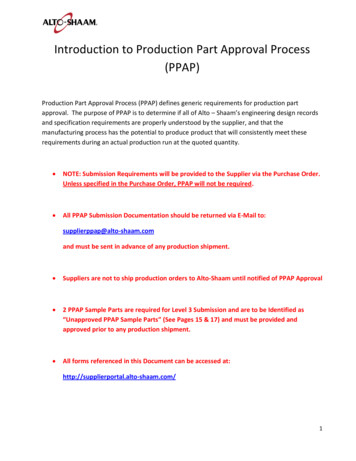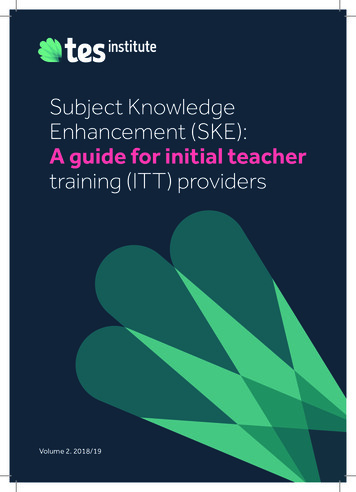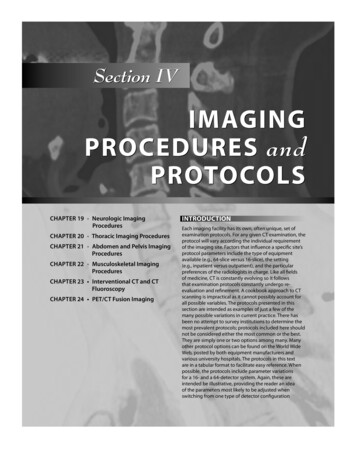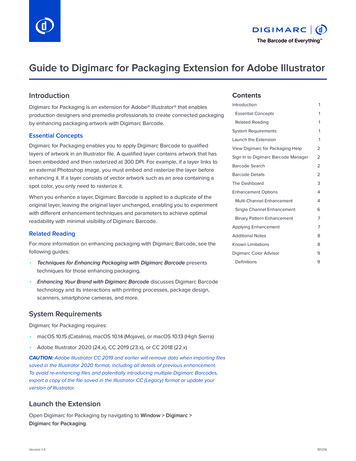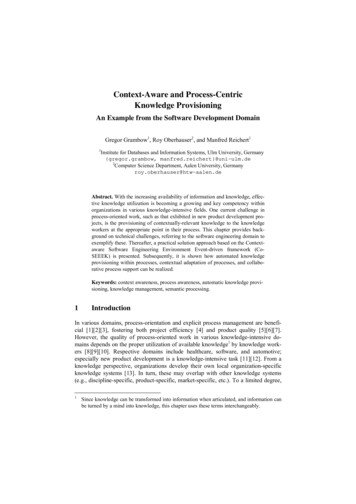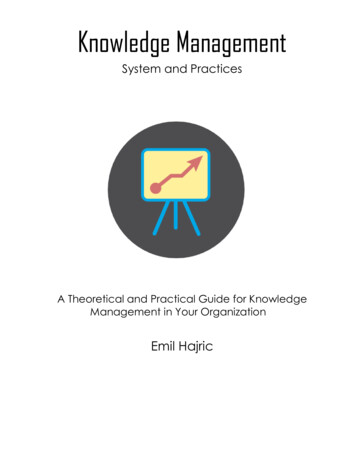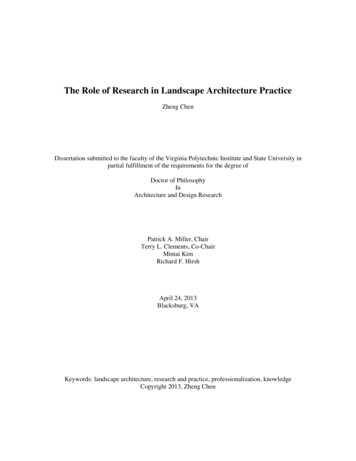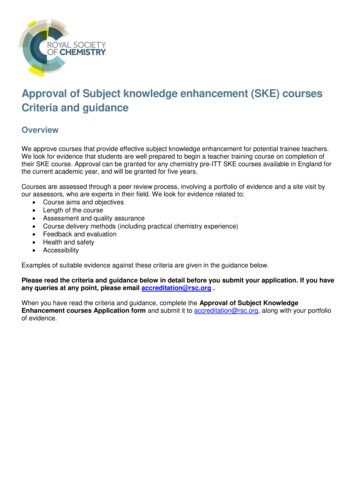
Transcription
Approval of Subject knowledge enhancement (SKE) coursesCriteria and guidanceOverviewWe approve courses that provide effective subject knowledge enhancement for potential trainee teachers.We look for evidence that students are well prepared to begin a teacher training course on completion oftheir SKE course. Approval can be granted for any chemistry pre-ITT SKE courses available in England forthe current academic year, and will be granted for five years.Courses are assessed through a peer review process, involving a portfolio of evidence and a site visit byour assessors, who are experts in their field. We look for evidence related to: Course aims and objectives Length of the course Assessment and quality assurance Course delivery methods (including practical chemistry experience) Feedback and evaluation Health and safety AccessibilityExamples of suitable evidence against these criteria are given in the guidance below.Please read the criteria and guidance below in detail before you submit your application. If you haveany queries at any point, please email accreditation@rsc.org .When you have read the criteria and guidance, complete the Approval of Subject KnowledgeEnhancement courses Application form and submit it to accreditation@rsc.org, along with your portfolioof evidence.
1.0 IntroductionAs part of the standards for attaining Qualified Teacher Status (QTS), trainee teachers must demonstrate ahigh level of subject knowledge and pedagogy. For science teachers this has added importance, becausemost are required to teach all three sciences to students up to age 16.“Standard 3: Demonstrate good subject and curriculum knowledge - have a secure knowledgeof the relevant subject(s) and curriculum areas, foster and maintain pupils’ interest in thesubject, and address misunderstandings.” (Teachers’ Standards, DfE, 2011)Pre-Initial Teacher Training Subject knowledge enhancement (pre-ITT SKE) courses are designed to upskill potential trainee teachers by filling the gaps in their knowledge of their specialist subject. Courses canlast from eight to 36 weeks, depending on the needs of the trainee. The courses can deliver knowledge upto either pre-16 or post-16 standard, and are funded entirely by the Department for Education. Trainees areput forward for a pre-ITT SKE course by their potential teacher training provider, and a teacher trainingplace can be offered conditional on completion of a pre-ITT SKE course. Around a quarter of traineechemistry teachers use pre-ITT SKE courses to develop their subject knowledge before beginning theirteacher training course.1Pre-ITT SKE providers may apply for approval of their courses. This highlights high quality training tostudents, schools and Initial Teacher Training (ITT) providers, and supports students in their subjectknowledge development.Our approval process is one of peer review, involving assessment against set criteria by members that areexpert in their field. Outcomes of assessment are governed by the Admissions Committee and EducationDivision Council.2.0 EligibilityWe will assess any chemistry pre-ITT SKE course available in England for the current academic year. Thismay include courses provided by HEIs, schools, colleges or third party suppliers, eg Science LearningCentres. These courses may be part-time or full-time, and include both online and face to face deliverymethods.The criteria for approval are outlined in this document. Approval is normally granted for five years, althoughannual review may be required at the discretion of the 426/201403%20jb%20to%20sos%20for%20website.pdf2
3.0 Application process1. If you are interested in applying for approval, please contact us at accreditation@rsc.org to discuss theprocess before you begin your application.2. Once you have decided to apply for approval, please complete the Approval of Subject KnowledgeEnhancement courses Application form. You will also need to provide a portfolio of supporting evidencethat the course meets the criteria detailed below. Note that the examples of evidence given are notexhaustive and not all examples will be relevant to all course types.Please send your submission to accreditation@rsc.org, or, if hard copies are included, to:Accreditation teamRoyal Society of ChemistryThomas Graham House290-292 Science ParkMilton RoadCambridgeCB4 0WF3. Our assessors and staff will arrange a site visit. The aim of the site visit is to find out more about thefacilities and resources used to deliver the course, and to speak to the course tutors in more detail.4. The assessors will review all the evidence collected from the application form and the site visit, andmake one of the below decisions:i. The course should be approved for a period of five years.ii. The course should be approved for a period of five years, with annual review required.iii. The course should be approved subject to specific recommendations being implemented. Furtherassessment of the course following implementation of recommendations will be necessary beforeapproval can be finalised.iv. The course should not be approved. Reapplication at a later date is permitted.We reserve the right to remove approval at the discretion of our Admissions Committee5. Once a course is approved, the Royal Society of Chemistry should be provided with updates of anysignificant changes to structure and/or materials.3
4.0 CriteriaThe approval process will assess the degree to which students will achieve the following competencies oncompletion of the course.Chemistry pre-ITT SKE for pre-16Chemistry pre-ITT SKE for post-16Competent subject knowledge of chemistry atpre-16Competent subject knowledge of chemistry atpost-16Ability to plan and deliver safely riskassessed practical experiments to supportlearning at pre-16Ability to plan and deliver safely riskassessed practical experiments to supportlearning at post -16Skills sufficiently developed to analyse andinterpret data at pre-16Skills sufficiently developed to analyse andinterpret data at post -16Skills sufficiently developed to communicatechemical concepts succinctly at pre-16Skills sufficiently developed to communicatechemical concepts succinctly at post -16Skills sufficiently developed to synthesiseand simplify models and theories to explainchemical phenomena succinctly at pre-16Skills sufficiently developed to synthesiseand simplify models and theories to explainchemical phenomena succinctly at post -16Ability to recognise and addressmisconceptions about chemical concepts atpre-16Ability to recognise and addressmisconceptions about chemical concepts atpost -16Ability to use digital technologies competentlyto enhance the learning of chemistry at pre16Ability to use digital technologies competentlyto enhance the learning of chemistry at post 16Develop and apply knowledge andunderstanding of chemistry in a wider contextto support learning at pre-16Develop and apply knowledge andunderstanding of chemistry in a wider contextto support learning at post -16Ability to plan and deliver qualitativeexperimental aspects to enhance learning atpre-16Ability to plan and deliver qualitativeexperimental aspects to enhance learning atpost -16Ability to plan and deliver quantitativeexperimental aspects to enhance learning atpre-16Ability to plan and deliver quantitativeexperimental aspects to enhance learning atpost -16The aspects of the SKE course which will be assessed are detailed below, along with suggestions ofsuitable evidence to meet each criterion. Please note that providers do not need to provide all the types ofevidence suggested here.4
1 Course aims1.1 Students completing the course should demonstrate the competencies given above.Appendix 1 contains a detailed subject knowledge audit which indicates the level of subject knowledge atrainee should have at the end of both a pre-16 and post-16 course. Appendix 2 contains guidance on thepractical chemistry which should be undertaken as part of a pre-ITT SKE course.1.2 The aims and intended learning outcomes of the course, and benefits to students, should be clear.Suitable evidence: Webpage outlining course objectives, intended learning outcomes etc. Any material provided to participants in advance of the course.2 Length of course2.1 The length of the course should be determined by the SKE provider, and be indicative of individualstudents’ needs, based on the outcome of an initial subject knowledge audit.Suitable evidence: Subject knowledge audit used to assess students’ needs Documentary record of process used for addressing students’ needs3 Assessment and quality assurance3.1 The intended learning outcomes of the course should be clearly met on completion.Suitable evidence:In addition to self-assessment, SKE students will be assessed through a variety of means, evidence ofwhich will be suitable for the approval process. These should include: Production of a portfolio of work Laboratory bookEvidence may also include any of the below: Formal end of course assessmentsReflective logsConcept mapsMicro-teaching and presentationsEngagement in outreach activitiesThis evidence should be formally assessed and signed off by the course tutor, who should be a chemistryspecialist.4 Course delivery4.1 Teaching and learning methods should be appropriate and should exemplify best practice in chemistrypedagogy.Suitable evidence: Course materials, eg PowerPoint slides, hand-outs, workbooks For online courses, URL and associated details to access course5
4.2 Appropriate materials and resources are provided to allow students to engage effectively with thecourse material, in particular with the practical chemistry aspects of the courseSuitable evidence: Examples of course materials and resources provided Evidence of resources available for practical aspects of the course4.3 Course tutors should have qualifications and/or experience appropriate to their role and degree ofinvolvement in the course.Suitable evidence: Course tutor(s) CV(s) and certificates of qualification (eg CChem, CSciTeach) Documentary record of “Train the trainer” and CPD initiatives Documentary record of quality assurance processes4.4 The mode of delivery of the course should be appropriate to provide students with sufficient knowledgeand skills on completion of the course.Participants for SKE can be taught through a variety of methods, some example of which are listed below.Providers should submit suitable evidence of the methods used, eg course timetables. Face to face tutorials (may include remote video tutorials eg Skype) – the recommended numberbeing:o 8-15 week course – 2 tutorialso 16-23 week course – 3 tutorialso 24-36 week course – 4 tutorialsOn-site face-to-face teachingLaboratory based practical workDistance learningBlended learningMicroteaching and presentationsEngagement in outreach activitiesPlease note, we recommend that at least 15% of the course is spent undertaking supervisedlaboratory work. A minimum of 10% may be considered acceptable at the discretion of theassessors. Appendix 2 contains recommendations for the undertaking of practical chemistry in pre-ITTSKE courses.5 Feedback and evaluation5.1 Feedback should be requested from students, analysed and acted upon by the training provider.Suitable evidence: Feedback forms distributed to students (during and/or after the course) Documentary record of updates/alterations to course as a result of participant feedback Documentary record of internal quality assurance processes6
6 Health and safety6.1 Student health and safety must be ensured while undertaking the course.Suitable evidence: Risk assessment documentation Environment, health and safety guidance provided to participants Health and safety guidance and risk assessments for any practical activities undertaken aspart of the course7 Accessibility7.1 Course providers should ensure that there are no exclusions to participation based on accessibility orspecific learning difficulties, once participants have met the entry criteriaSuitable evidence: Document or webpage describing venue accessibility Description of accessibility of any websites used Evidence of consultation with appropriate organisations Diversity policy5.0 ContactIf you have any queries about your application, or would like to receive more information, please contact usat accreditation@rsc.org.7
Appendix 1: Subject knowledge content outcomes – theoretical chemistryThe following comprises an indicative audit of the key content and concepts a student should be familiarwith on completion of an SKE course, for both pre- and post-16. This audit can be used directly withstudents to ascertain their depth of knowledge and understanding before, during and/or after their trainingcourse.Although the particular elements may be covered in more than one age range, coverage of the conceptsshould be regarded as stage related.8
Theme 1: Inorganic ChemistryAtoms and atomic structureThe student is able to Explain the Particle Theory forsolids, liquids and gasesUse particle theory to explain arange of phenomena egevaporation, dissolution, freezing,boiling, melting, sublimationExplain what is meant by the termsatom, element, molecule andcompoundGive the main postulates of Dalton'satomic theoryDiscuss the atomic model proposedby DaltonDiscuss the atomic model proposedby ThomsonDiscuss and interpret the Rutherfordgold foil experimentDiscuss the Rutherford model of theatomDiscuss the component particles ofthe atom (electron, proton, neutron)Recall the relative mass and chargeof a proton, neutron and an electronWrite the electronic configurationsfor the first 20 elements and drawtheir electronic diagramsWrite the electronic configurationsfor the first 36 elements using s, pand d notationExplain how the number of outershell electrons is related to anelement’s group number in theperiodic tableExplain the following terms atomic number mass number isotope relative atomic massNo knowledge543Excellent pre1621post16 9
Relative formula masses and molar volumes of gasesThe student is able to Explain the concept of the moleincluding: Avogadro’s number Application to symbol equationsCalculate the relative atomic mass ofan element from given relativeabundances of its isotopesCalculate relative formula masses(Mr) from relative atomic masses (Ar)Use the term mole correctly (amountof a substance) and in the context ofa calculationPerform calculations using relativeatomic mass (Ar) and relativeformula mass (Mr)Calculate the molar volume of a gasNo knowledge543Excellent21pre16post16 pre16post16 Chemical formulae and chemical equationsThe student is able to Calculate empirical and molecularformula from data (can also beexperimental data)Calculate the molar concentration ofan unknown solutionCalculate the reacting mass of asubstance using experimental dataand chemical equationsNo knowledge54310Excellent21
Ionic compounds, covalent substances and metallic crystalsThe student is able to Explain what oxidation is in terms ofoxygen, hydrogen and electronsExplain what reduction is in terms ofoxygen, hydrogen and electronsExplain how the charge of an ioncan be deduced from the electronicconfiguration of its atomDefine that an ionic bond is a strongelectrostatic attraction betweenoppositely charged ionsDraw and explain how ions and ionicbonding can be represented by ‘dotand cross’ diagrams e.g. NaCl, MgO,CaCl2, AlCl3 & Al2O3Explain the relationship betweenionic charge and the melting pointand boiling point of an ioniccompoundDraw and explain the positions ofthe ions in a crystal of sodiumchlorideDefine that a covalent bond isformed by the sharing of a pair ofelectrons between two atomsUse ‘dot and cross diagrams’ toexplain the covalent bonding foroxygen, nitrogen, methane, water,ammonia, carbon dioxide, ethaneand etheneExplain why simple molecularstructures have low melting points interms of the relatively weak forcesbetween the moleculesExplain why giant covalent(macromolecular) structures havehigh melting points, in terms of thebreaking of many strong covalentbondsDraw and explain the molecularstructures of diamond and graphiteExplain at least two uses of diamondand graphite, which depend on theirpropertiesExplain the use of carbon in newtechnologies, eg nanotechnologyand fullerenesNo knowledge54311Excellent21pre16post16
The student is able to Draw and explain how a metal is agiant structure of positive ionssurrounded by a sea of delocalisedelectrons e.g. Na or KExplain the malleability and electricalconductivity of a metal in terms of itsstructure and bondingExplain the geometry of simplemolecules using VSEPR theory, egH2O, NH3, CH4, CO2, C2H4, C2H6,BF3, SF6No knowledge543Excellent21pre16post16 Group lNo knowledgeExcellent prepost1616The student is able to 54321Explain the reactions of the elements in Group I with the following substances,their trends in reactivity and write balanced chemical equations for the reactions: water oxygen chlorineExplain the relative reactivity of theelements in Group l in terms of distance between the outer electronsand the nucleus12
Group VllNo knowledge543Excellent21pre16The trainee is able to Recall and explain the colours andphysical states of the Group VII elements at room temperatureExplain the reactions of the halogens / halides (including balanced chemicalequations) with the following substances: water oxygen chlorineExplain the above reactions in termsof electronegativityExplain and write balanced chemical equations for the reactions of GroupVII non-metals with Group I metalsWrite balanced chemical and ionicequations that explain how a more reactive halogen will displace a lessreactive halogen from a solution ofone of its salts (redox reactions)Explain how to identify halide ions using silver nitrateUnderstand why acidified silvernitrate solution is used as a reagent to identify and distinguishbetween F- , Cl- , Br- , IDescribe the trend in solubility of thesilver halides in ammoniaDescribe the uses of chlorine and chlorate(I) Know the reactions of chlorinewith water and the use ofchlorine in water treatmentAppreciate that the benefits tohealth of water treatment bychlorine outweigh its toxic effectsKnow the reaction of chlorinewith cold, dilute, aqueous NaOHand the uses of the solutionsformedpost16 13
MetalsNo knowledge543Excellent21pre16post16The student is able to Explain how metals can be arrangedin a reactivity series based on the reactions of the metals and theircompoundsElectrode potentialsKnow the IUPAC convention for writing half-equations for electrodereactionsKnow and be able to use the conventional representation of cellsUnderstand how cells are used tomeasure electrode potentials by reference to the standard hydrogenelectrodeKnow the importance of the conditions when measuring theelectrode potential, EKnow that standard electrodepotential, E , refers to conditions of 298 K, 100 kPa and a 1.00 mol dm-3solution of ions.Electrochemical seriesKnow that standard electrode potentials can be listed as anelectrochemical seriesBe able to use E values to predictthe direction of simple redox reactions and to calculate the e.m.fof a cellKnow the electrochemical series described by the reactions of metals with: water dilute acidsWrite balanced chemical equations for the displacement reactions, in the contextof the reactivity series, between: metals and their oxides metals and their salts in aqueous solutionsDefine and explain the terms redox, half-reaction, oxidising agent andreducing agentConstruct redox equations using relevant half-equations, including for: copper and sodium hydroxide iron (II) and sodium hydroxide iron (III) and sodium hydroxide aluminium and sodium hydroxide14
The student is able to Write full equations for the abovereactions, including complex
We will assess any chemistry pre-ITT SKE course available in England for the current academic year. This may include courses provided by HEIs, schools, colleges or third party suppliers, eg Science Learning Centres. These courses may be part-time or full-time, and include both
